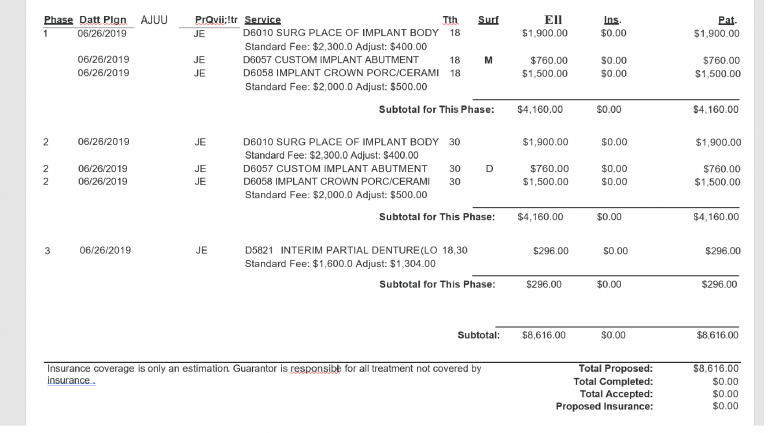
Dental Code D7286: Incisional biopsy of oral tissue-soft
Dental Code D7286 pertains to the incisional biopsy of soft oral tissue, a crucial diagnostic procedure used to evaluate and analyze suspicious or abnormal lesions within the oral cavity. This specific code signifies a dental service that involves the surgical removal of a small portion of tissue from the affected area, enabling further examination and analysis.
Dental Code D7286 Price Range
On average, patients pay $340 for this D7286 service at the dentist's office, with as little as $225 charged for this in less expensive cities and as much as $490 in more expensive cities.
Low cost of living | Medium cost of living | High cost of living |
Memphis (Tennessee), Cincinnati (Ohio) | Miami (Florida), Denver (Colorado), Austin (Texas) | (New York (New York), San Francisco (California) |
$225 | $340 | $490 |
However, the price for the service D7286 depends not only on the region where you live, but also varies from dentist to dentist. Therefore, it makes sense to compare prices before choosing a dentist. The best way to do this price comparison is at Dr. BestPrice and save a lot of money.
What does Dental Code D7286 mean? Detailed Information about the Procedure and Steps
Dental Code D7286 refers to a specific alphanumeric identifier used in dental billing and insurance claims to represent the procedure known as the "incisional biopsy of oral tissue-soft." This code is specifically associated with the surgical removal of a small portion of soft oral tissue for further examination and analysis.
The purpose of Dental Code D7286 is to provide a standardized method for dental professionals, insurance companies, and other stakeholders to communicate and document this particular diagnostic procedure. By using this code, dental practitioners can accurately report and bill for the incisional biopsy of soft oral tissue, ensuring proper reimbursement and record-keeping.
Clinical Evaluation and Assessment
The initial step in an incisional biopsy is a comprehensive clinical evaluation conducted by a highly skilled dentist or oral surgeon. During this evaluation, the dentist carefully examines the oral cavity, paying specific attention to the lesion or abnormal tissue. They assess various aspects such as the size, shape, color, and texture of the lesion. This evaluation is crucial in determining the necessity of a biopsy and guides subsequent steps in the process.
Administration of Local Anesthesia
To ensure patient comfort throughout the procedure, local anesthesia is administered. The dentist or oral surgeon uses a small needle to inject a numbing agent into the area surrounding the lesion. This local anesthetic effectively numbs the tissue, minimizing any potential discomfort or pain during the biopsy.
Incision and Tissue Sampling
Once the area is adequately anesthetized, the dentist or oral surgeon proceeds to make a small incision in the oral tissue. The incision is carefully placed to obtain a representative sample of the lesion. Specialized instruments, such as scalpels or biopsy punches, are then used to excise a small piece of the abnormal tissue. This tissue sampling is performed with precision and skill to ensure an accurate representation of the lesion for further analysis. Following the tissue sampling, the incision is closed using dissolvable sutures or sutures that will be removed during a subsequent follow-up appointment.
Hemostasis and Postoperative Instructions
After obtaining the tissue sample, the dentist or oral surgeon ensures proper hemostasis or control of bleeding in the area. This may involve the use of sterile gauze or other hemostatic agents to aid in the process. Once bleeding is controlled, the patient is provided with postoperative instructions. These instructions may include guidance on oral hygiene practices, such as gentle brushing and rinsing, as well as dietary restrictions to promote healing. If necessary, the dentist may also prescribe medications to manage pain or prevent infection.
Laboratory Analysis and Results
The excised tissue sample is carefully preserved and sent to a pathology laboratory for analysis. Skilled pathologists with expertise in oral pathology examine the sample under a microscope, studying its cellular composition and identifying any abnormalities or signs of disease. The laboratory analysis plays a critical role in accurately diagnosing the condition or disease associated with the lesion. Based on the pathology report, the dentist or oral surgeon can determine the appropriate treatment plan tailored to the patient's specific needs.
Follow-up and Treatment Planning
Once the pathology report is available, the dentist or oral surgeon reviews the results with the patient. If the biopsy confirms the presence of a specific condition or disease, further treatment planning is initiated. This may involve additional surgical procedures, such as excision of the entire lesion, referral to a specialist, or other appropriate interventions. The treatment plan aims to address the underlying issue and promote optimal oral health.
Summary of Dental Code D7286
Dental Code D7286, involving the incisional biopsy of soft oral tissue, is a vital procedure in diagnosing oral lesions and abnormalities. Through meticulous clinical evaluation, local anesthesia administration, incision and tissue sampling, hemostasis, laboratory analysis, and follow-up, this diagnostic technique provides valuable information for determining the nature of the lesion and developing an appropriate treatment plan.
By employing dental code D7286, dental professionals can accurately diagnose conditions such as oral cancers, precancerous lesions, and other pathological abnormalities, enabling timely intervention and improved patient outcomes. If you have any concerns regarding suspicious oral lesions, it is essential to consult a dentist or oral surgeon who can guide you through the process, including the potential necessity for an incisional biopsy using dental code D7286.
Unleash the power of smart spending with Dr. BestPrice! Your smile's future looks brighter already. Discover the transformative potential of Dr. BestPrice and unlock a world of smart spending that will revolutionize your dental care experience. With Dr. BestPrice, your smile's future shines even brighter, as you gain access to a range of benefits and savings.
